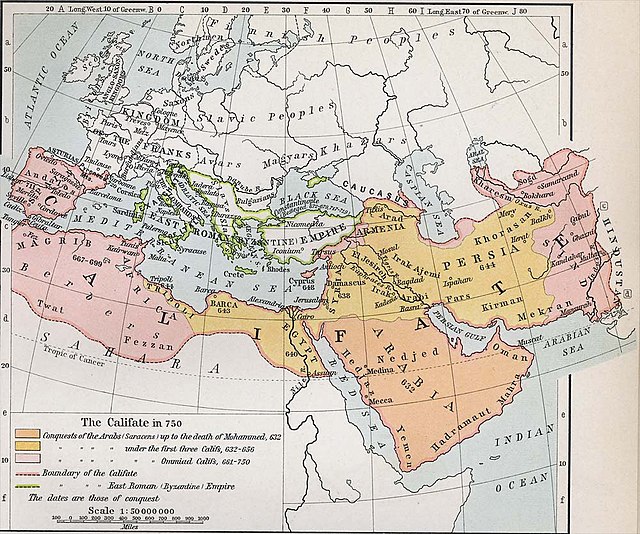Abu Muhammad al-Hajjaj ibn Yusuf ibn al-Hakam ibn Abi Aqil al-Thaqafi, known simply as al-Hajjaj ibn Yusuf, was the most notable governor who served the Umayyad Caliphate. He began his service under Caliph Abd al-Malik, who successively promoted him as the head of the Caliph's shurta, the governor of the Hejaz in 692–694, and the practical viceroy of a unified Iraqi province and the eastern parts of the Caliphate in 694. Al-Hajjaj retained the last post under Abd al-Malik's son and successor al-Walid I, whose decision-making was heavily influenced by al-Hajjaj, until his death in 714.
Seal of al-Hajjaj ibn Yusuf
Sasanian-style dirham minted by al-Hajjaj in 695
Silver dirham following Sasanian motives, struck in the name of al-Hajjaj
The Umayyad Caliphate or Umayyad Empire was the second caliphate established after the death of the Islamic prophet Muhammad and was ruled by the Umayyad dynasty. Uthman ibn Affan, the third of the Rashidun caliphs, was also a member of the clan. The family established dynastic, hereditary rule with Mu'awiya I, the long-time governor of Greater Syria, who became caliph after the end of the First Fitna in 661. After Mu'awiya's death in 680, conflicts over the succession resulted in the Second Fitna, and power eventually fell to Marwan I, from another branch of the clan. Syria remained the Umayyads' main power base thereafter, with Damascus as their capital.

Arab-Sasanian-style Umayyad coin minted under Mu'awiya I rule in Basra in 675/76 in the name of the Umayyad governor Ubayd Allah ibn Ziyad. The latter's governorship later spanned all of the eastern caliphate. His father Ziyad ibn Abihi was adopted as a half-brother by Mu'awiya I, who made him his practical viceroy over the eastern caliphate.
Abd al-Malik introduced an independent Islamic currency, the gold dinar, in 693, which originally depicted a human figure, likely the caliph, as shown in this coin minted in 695. In 697, the figural depictions were replaced solely by Qur'anic and other Islamic inscriptions
The expansion of the Muslim Caliphate until 750, from William R. Shepherd's Historical Atlas. Muslim state at the death of Muhammad Expansion under the Rashidun Caliphate Expansion under the Umayyad Caliphate Byzantine Empire
A 14th-century illustration of the siege of Constantinople







